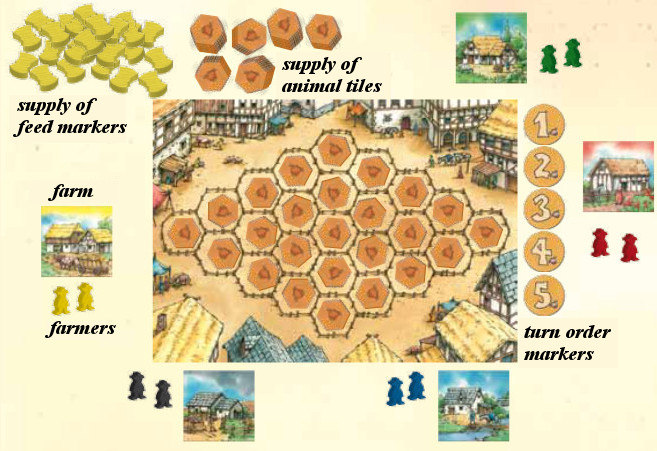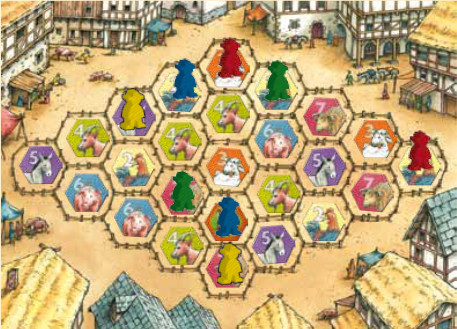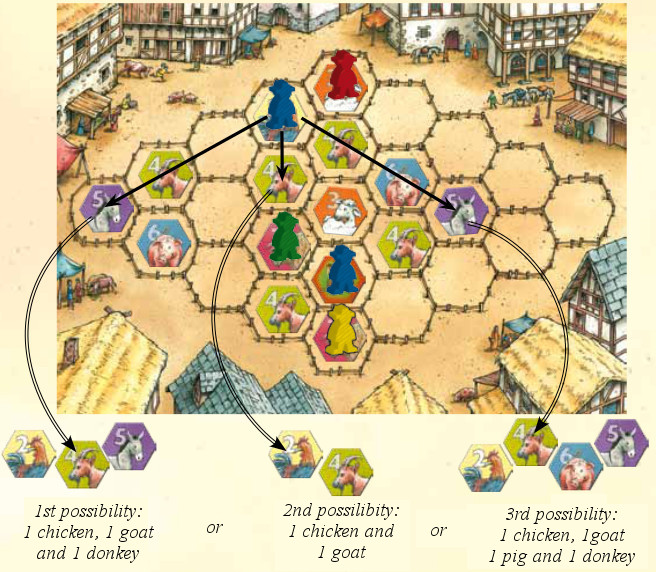Schweinebande (Gang of Pigs)
The following rule changes apply here on yucata.de:
To fasten the game every player scores and feeds his animals after taking back his own last farmer. According to the original rules
scoring and feeding would be an extra game phase after ALL players have taken back all their farmers.
Introduction
Every Wednesday shortly after sunrise there is a cattle market in town. Goats, donkeys, cows and of course pigs are
offered here for sale.
The offers are varying and of different value to each player. So every player has to deliberate about whether to snatch
quickly at the offer without knowing exactly what he will get. Or to wait patiently until every offer is certain.
Every player went to the market with some assistants - 6 eyes can see more than 2 - to get the best offers. After the purchased
cattle is fed they are going back home because it's not the farmer with the biggest potatoes winning the game but the one with
the most animals in the barn.
Contents
1 game board, 15 wooden farmer figures (3 each in the colors blue, yellow, green, red, black), 5 farms, 25 wooden feed markers, 5 numbered turn order tiles and 100 hexagonal animal tiles (96 animals - 16 each of 6 animal types plus four feed bags).
Setup
The board is placed in the middle of the table.
The 25 markers are placed beside the board.
Each player takes two farmers (if 4-5 players) or 3 farmers (if 2-3 players) of a color and a farm of the same color, but no feed marker.
The 5 turn order tokens are placed face up next to the board.
The 100 hexagonal animal tiles are mixed together face down and arranged into multiple piles next to the board.
(cf. A. Place animal tiles).

Game Play
The game is played over four rounds. Each round is divided into the following sections:
- A. Place animal tiles
- B. Place farmers
- C. Collect animal tiles
- D. Place animal tiles on the farm
- E. Feeding
A. Place animal tiles
At the beginning of each round the players lay 25 animal tiles face down on the board's 25 hexagonal spaces. Thus the 100 animal tiles suffice for 4 rounds.
B. Place farmers

The first round is begun by the youngest player who reveals one animal tiles. Then he must decide whether to place one of his farmers on this tile or not. Then, it is the turn of the next player clockwise order.
Once a player's last farmer has been placed, he immediately takes the lowest-numbered turn order marker still available. This player takes no more actions and may not reveal any more animal tiles in this phase. He is simply skipped. When there is only one player having one or more farmers remaining, he continues to reveal one animal tile after another. After each he has the opportunity to place a farmer. His last farmer figure must be placed no later than the last such tile revealed. Should it happen that a player has one or more farmers, but all animal tiles have revealed, he is not allowed to place these farmers in this phase.
After the very last farmer has been placed any remaining unrevealed animal tiles are now also revealed.
C. Collect animal tiles
The player with the "1" turn order marker begins the collection of animal tiles. He selects one of its farmers and collects all the animal tiles extending out in a row from this farmer. Then the rest of the players do the same in the order of their turn order markers (not clockwise!). When every other player has thus had a chance to collect at row, start again with the "1" player. He takes a second figure and again receives several animal tiles, etc. In game with two or three players only, there is also a third round of collecting animals. When collecting the following rules apply:
- The player does take the animal tile that is directly beneath his farmer.
- He takes all still unclaimed animal tiles in the row of his choice, emanating from the farmer.
- A row ends either at the edge of the play area or at just before any other farmer or at the last animal tile in this row.
- An empty space does not end a row.
- The player takes the farmers back into his personal supply.
In Example 3 players have already collected animals with their first farmers. Red has taken 2 chickens, 1 donkey and 1 cow. Yellow has collected 1 chicken, 1 donkey and 1 pig while Green has collected 1 chicken, 1 sheep and 1 cow. Blue now has three different rows to choose from: (see the illustration showing three different arrows emanating from the blue farmer: 1. 1 chicken, 1 goat and 1 donkey; 2. 1 chicken and 1 goat; 3. 1 chicken, 1 goat, 1 pig and 1 donkey).

The taken animal tiles are placed face up on the table before their owners. Animal tiles which are the same are placed under one another.
Animal tiles still on the board and not taken by any player are removed from the game and placed back into the box. This phase then ends.
D. Place animal tiles on the farm
Modification to the original rules: Each player scores and feeds his animals directly after taking back his last farmer and not in an extra game phase after ALL players
have taken back their farmers.
Now all players can put animals on their farm. The following rules apply:
- Group of 4: The player has collected 4 animal tiles the same kind, e.g. 4 donkeys. He places 1 donkey on his farm and the remaining 3 back in the box. Should he have further donkeys but not enough to make another group of four they simply remain where they are.
- Group of 6: The player has collected at least 1 of each kind of animal, that is, 1 chicken 1 sheep, 1 goat, 1 donkey, 1 pig and 1 cow. He puts the cow on his farm and the 5 remaining animals back into the box.
- An animal may not be duplicated, that is cannot be used both in a group of 4 and also in a group of 6.
- A player need not turn in any group. He can simply leave the animals where they are. This can be useful if ...
... the player has four pigs and wants to turn them in on the last turn (see Pig Premium).
... the player is hoping an animal, e.g. with a small number, can later be used in a group of 6.
Only animals on the farm earn points at the end of the game. A donkey on the farm, for example, is worth 5 points, etc.
Pig premium on the last round
In the fourth and final round should a player have 4 pigs before him [around here that seems to happen every gaming session], he places two of them on his farm and the other two back in the box. Had he 8 pigs, 4 of them go to the farm, 12 pigs earn 6, etc.
E. Feeding
All players must feed all of their animals not in the farm. Every animal needs 1 feed marker. If a player has no feed marker, he must sell one or more animals. An animal is worth as many feed markers as its number indicates. For example a pig is worth 6 feed markers.
Example: Blue has 7 animals (as in the example on page 4): 1 chicken, 3 goats, 1 donkey and 2 pigs, and no feed markers. He sells his donkey and his chicken to earn 7 feed markers. The donkey and chicken are removed from play. For the now 5 animals remaining he pays 5 feed markers to the supply. He has 2 feed markers remaining for the next Round.
A collected feed bag may be used to feed all of one's animals once. Then the feed bag is put back in the box. However, a player is not forced to use it and may instead feed his animals using feed markers and save his feed bag. Once all players have fed their animals, the round ends.
Subsequent Rounds
All remaining rounds are the same as the first, with the following exceptions:
A. Place animal tiles (as usual)
B. Place farmers
Now the first player is the one with the "1" turn order token. After this player reveals an animal tile and possibly places a farmer, all players return their turn order markers to the supply. Play continues in clockwise order.
C-E. (as usual)
Special features at the end
After all players in the fourth and final round have placed their figures on the board, collected animal tiles, placed animals in the farm and fed their remaining animals, the following occurs:
Now, each player may turn in any 4 animal tiles as a group of 4, so long as he still has 4 or more animal tiles and place the lowest-valued of these tiles on his farm.
If a player, for example, has 2 cattle and 2 goats, he puts one goat on his farm and the other three animals in the box.
If a player has 8 or more animal tiles, he may redeem two or even more groups of 4. Animal tiles and feed sacks which can not be redeemed are also placed back the box.
Scoring
Each player counts the points of the animals on his farm. Every animal score the printed number: 2, 3, 4, 5, 6 or 7 points. The player with the most points wins the game. Should there be a tie, the winner is the player with the most pigs. If there is still a tie, there are multiple winners.
Tips
- If a player has, for example, 2 donkeys from a previous round, he should see that he receives 2 more in this round.
- To receive the Pig Premium in the last round, it may be worth it not to turn in pigs, but continue to feed them instead.
- In feeding, players should be sure to have set aside at least 4 animal tiles to turn them at the end as a group of 4. Thus it may be preferable to sell a more valuable animal than two less valuable ones.
translation from spotlightongames